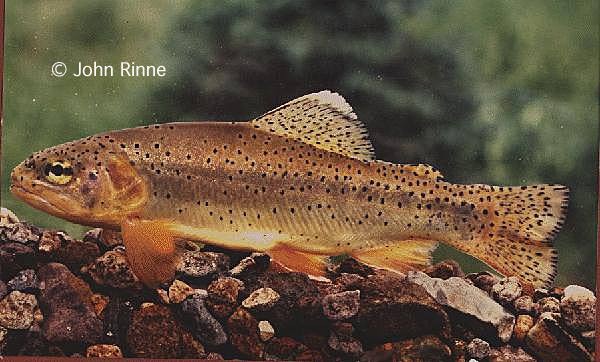Apache Trout (Oncorhynchus gilae apache) - Wiki Apache trout
From Wikipedia, the free encyclopedia
Order: Salmoniformes
Family: Salmonidae
Synonyms: Oncorhynchus apache
[Photo] Apache Trout (Oncorhynchus gilae apache). Author: John Rinne. Source: www.fws.gov/arizonaes/images/SpeciesImages/Apache_Trout.jpg License: public domain.
The Apache trout or Arizona trout, Oncorhynchus gilae apache, is a species of freshwater fish in the salmon family (family Salmonidae) of order Salmoniformes. It is one of the trouts.
The Apache trout measures in length from 6 to 24 inches, and weighs between 6 ounces and 6 pounds. It is a yellowish-gold color and has medium-sized dark spots that are evenly spaced and that may extend below the lateral line and onto the dorsal and tail fins. The top of its head and back are dark olive in color, and it has the appearance of having a black stripe through each of its eyes, due to two small black dots on either side of the pupil. There is a cutthroat mark below the lower jaw, ranging in color from yellow to gold.
The Apache trout is the state fish of Arizona, and is one of only two species of trout native to that state (the other being the gila trout). It natively lives in clear, cool streams in the White Mountains that flow through coniferous forests and marshes, but has been introduced into several lakes in the area. Apache trout stocked in the Pinaleno Mountains and on Mount Graham, farther west in Arizona, are reproducing.
The Apache trout spawns from March to the middle of June. One female typically produces from 200 to 600 eggs, but may produce as few as 70 or as many as 4000. The eggs hatch after 30 days. It takes up to 3 years for the fish to fully mature.
The Apache trout eats both terrestrial and aquatic insects, such as Trichoptera and Diptera. In lakes, they also eat small fishes and zooplankton.
While the IUCN considers the Apache trout to be critically endangered, it is listed as threatened under the Endangered Species Act. Around 100 years ago, they could be found in 600 miles of streams in the White Mountains. By the late 1960s, their range had been reduced to around 30 miles of these streams. Once the Endangered Species Act of 1969 was passed, they became one of the first species listed under it. When this act was replaced by the Endangered Species Act of 1973, they became one of the first fish species protected under the newer Act. Population numbers for this species are still rising.
Today, the main risk to the Apache trout is its easy hybridization with the rainbow trout. Populations that are considered to be genetically contaminated (containing hybrids) are exterminated. The Apache trout's still-limited range puts it at risk, but it is now common enough that limited fishing is permitted.
http://en.wikipedia.org/wiki/Apache_trout
| The text in this page is based on the copyrighted Wikipedia article shown in above URL. It is used under the GNU Free Documentation License. You may redistribute it, verbatim or modified, providing that you comply with the terms of the GFDL. |
